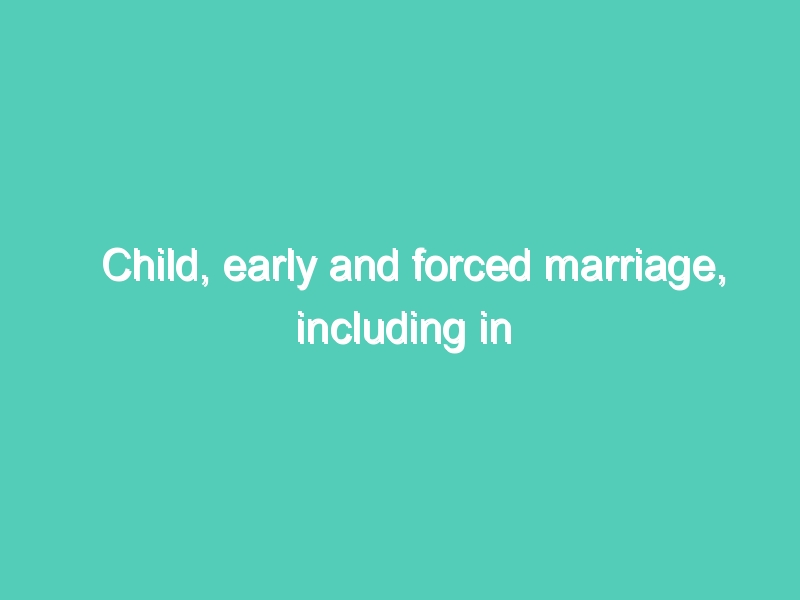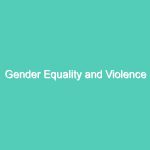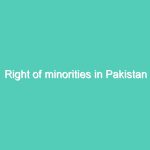| Child, early and forced marriage (CEFM) is a human rights violation and a harmful practice that disproportionately affects women and girls globally, preventing them from living their lives free from all forms of violence. CEFM threatens the lives and futures of girls and women around the world, robbing them of their agency to make decisions about their lives, disrupting their education, making them more vulnerable to violence, discrimination and abuse, and preventing their full participation in economic, political and social spheres. Child marriage is also often accompanied by early and frequent pregnancy and childbirth, resulting in higher than average maternal morbidity and mortality rates. CEFM often result in women and girls attempting to flee their communities or to commit suicide to avoid or escape the marriage.DefinitionChild marriage, or early marriage, is any marriage where at least one of the parties is under 18 years of age. Forced marriages are marriages in which one and/or both parties have not personally expressed their full and free consent to the union. A child marriage is considered to be a form of forced marriage, given that one and/or both parties have not expressed full, free and informed consent. Recent developments and events Call for submissions GA report on child, early and forced marriage (73/153 ) English | French | Spanish Call for submissions HRC oral update on the consequences of child, early and forced marriage (41/8) English | French | Spanish Call for submissions report on child, early and forced marriage in humanitarian settings English |French | Spanish High Commissioner oral update on CEFM in humanitarian settings, 25 June 2018, see Resolution A/HRC/RES/35/16 and HRC 38th session Annual full-day meeting on the rights of the child “Protecting the Rights of the Child in Humanitarian Situations”, 5 March 2018 Key OHCHR and SG reports Recommendations for action against child and forced marriage – OHCHR Compilation, September 2017 High Commissioner on Human Rights report – Expert workshop on the impact of existing strategies and initiatives to address child, early and forced marriage (A/HRC/35/5), 24 March 2017 SG report on Child, Early and Forced Marriage (A/71/253), 29 July 2016 OHCHR Summary report on the panel discussion on preventing and eliminating child, early and forced marriage (A/HRC/27/34, 18 July 2014) OHCHR report on preventing and eliminating child, early and forced marriage (A/HRC/26/22), April 2014 Video Panel Discussion on Accountability to children in Humanitarian Situations – March 2018 Expert workshop on Child, Early and Forced Marriages – October 2016 UN studies and reports A statistical snapshot of child marriage in West and Central Africa, UNICEF, 23 October 2017 Child, early and forced marriage legislation in 37 Asia-Pacific countries – Inter-Parliamentary Union (IPU) and World Health Organization (WHO), 2016 Global Programme to Accelerate Action to End Child Marriage, Progress Report 2016, UNFPA-UNICEF, June 2017 Child Marriage in Humanitarian Settings in the Arab Region (E/ESCWA/ECW/2015/2), Economic Commission for Western Asia, 2015 Other studies and reports Guide to good and promising practices aimed at preventing and combating female genital mutilation and forced marriage – Council of Europe, CDDH, 87 session, 13 July 2017 The Development of Global responses to CEFM, University Macquarie / HAQ Centre for Child Rights, 2017 Note: OHCHR is not responsible for the content of external studies and reports External links UNICEF UNFPA Girls not brides Note: OHCHR is not responsible for the content of external links Key international instruments addressing CEFM Joint general recommendation No. 31 of CEDAW and general comment No. 18 of the CRC on harmful practices CEDAW General recommendation No. 35 on gender-based violence against women, (updating general recommendation No. 19) CEDAW General recommendation No. 30 (fifty-sixth session, 2013) on women in conflict prevention, conflict and post-conflict situations Joint General Comment of the African Commission on Human and Peoples’ Rights (ACHPR) and the African Committee of Experts on the Rights and Welfare of the Child (ACERWC) on ending child marriage FiguresWorldwide, more than 650 million women alive today were married as children. Every year at least 12 million girls are married before they reach the age of 18. This is 28 girls every minute. One in every five girls is married, or in union, before reaching age 18. In the least developed countries, that number doubles – 40 per cent of girls are married before age 18, and 12 per cent of girls are married before age 15. The practice is particularly widespread in conflict-affected countries and humanitarian settings. (Source UNICEF).International human rights conventions and international entities stress the need to take measures to address CEFM. Over the last years, actions to end child, early and forced marriage have increased at international, regional and national levels (See A/HRC/RES/24/23; A/HRC/26/22; A/71/253). Specific efforts are undertaken to link these efforts to the implementation and monitoring the Sustainable Development Goals (SDGs), particularly Goal 5.3 to eliminate all harmful practices, such as child, early and forced marriage and female genital mutilations.Despite its prohibition by international law and many national legislations, the practice remains widespread. While the prevalence of child marriage is decreasing globally, with the proportion of women who were married as children decreased by 15 per cent in the last decade (from 1 in 4 to approximately 1 in 5), according to UNICEF. Yet, the prevalence rates of child marriage, early union, and adolescent pregnancy remain high, particularly in some regions. To end the practice globally, progress must be significantly accelerated and sustained. In its resolution A/HRC/RES/29/8 (22 July 2015) the Human Rights Council requested the UN High Commissioner for Human Rights to organize an expert workshop to review and discuss the impact of existing strategies and initiatives to address child, early and forced marriage and prepare a report on the deliberations held during the workshop to be submitted to the Council at its thirty-fifth session, which took place on 21 and 22 October 2016 (report A/HRC/35/5).In its resolution (A/HRC/RES/35/16, July 2017) the Human Rights Council noted with concern that the incidence and risk of child, early and forced marriage is highly exacerbated in humanitarian settings. This is due to various factors, including insecurity, gender inequality, increased risks of sexual and gender based violence, breakdown of rule of law and state authority, the misconception of providing protection through marriage, the use of forced marriage as a tactic in conflict, lack of access to education, the stigma of pregnancy outside of marriage, absence of family planning services, a disruption of social networks and routines, increased poverty, and the absence of livelihood opportunities, among others.In humanitarian contexts, ending CEFM requires increased attention, gender and age-sensitive approaches, appropriate protection, prevention and response measures and coordinated action by relevant stakeholders, with the full and meaningful participation of the women and girls affected, from the early stages of humanitarian emergencies. These efforts also require further recognition of the importance of addressing the increased vulnerability of women and girls to sexual and gender-based violence and sexual exploitation and abuse in humanitarian contexts.As a result, at the request of the Human Rights Council, the UN High Commissioner for Human Rights will present a written report, with input from all relevant stakeholders, on child, early and forced marriage with a focus on humanitarian settings at its forty-first session (June 2019), and is providing an oral update to the Human Rights Council at its 38th Session . |
Posted inArticles Latest News Prohibition of Child Marriage Rights of Children Rights of Marginalised Women & Children
Child, early and forced marriage, including in humanitarian settings



